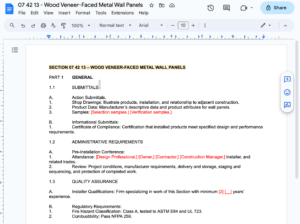We’ve seen 3-part specifications for construction grow in length, word count, and complexity through the years. We often hear design professionals say, “I need more words to make my specifications more enforceable.” But do you need more words to make a specification more enforceable?
Here’s an example of how words make specifications less enforceable.
What is the ultimate roofing warranty: “Roofing: Watertight”.
Anything you add to this statement will detract from the warranty.
What we often see this type of specification: “Roofing: Watertight for ten years.”
You had it watertight for eternity; why add words that diminish the original statement?
We find specifications have grown ever more wordy over the years for several reasons:
The mistaken belief that specifications must be lengthy and legal-sounding to be enforceable. Quite the opposite is true. Having shorter, easily understood specifications makes us less likely to have problems in the field.
The also mistaken belief that having lots of words protects us from a Contactor making mistakes. There is no way to include enough statements to protect yourself from a bad contractor, regardless of the length of your specification.
A desire to control the project and use the specifications to do so. You end up specifying the means and methods instead of simple, enforceable statements.
An example:
Good: “Install trim plumb, level, and rigid.”
Terrible: “Install trim by holding a 16-ounce hammer in your right hand and swinging it with sufficient force to drive nails into the trim and substrate, resulting in trim that is aesthetically pleasing and fully functional.”
But will adding more works make specifications more enforceable?
Let’s take a deep dive into why specifications in construction are so wordy and how we’ve all become accustomed to writing long specifications.



